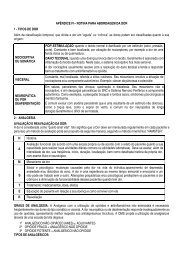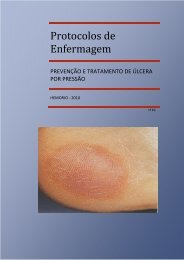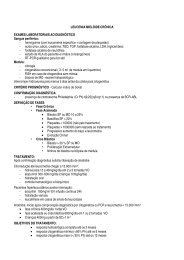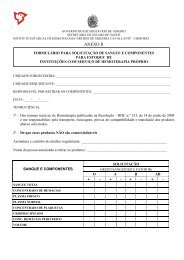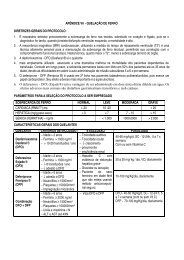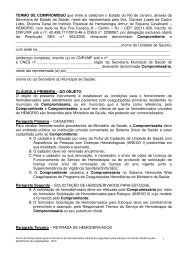Protocols - Hemorio
Protocols - Hemorio
Protocols - Hemorio
Create successful ePaper yourself
Turn your PDF publications into a flip-book with our unique Google optimized e-Paper software.
SPECIFICITIES OF EACH OPIATE (cont’):<br />
MORPHINE - It is a pure agonist, it does not present a maximum effect, the increase of the<br />
dose implies in an increase of the analgesia.<br />
- It must be prescribed when the two first steps of the analgesic ladder<br />
proposed by WHO are inefficient.<br />
- The risk of breathing depression is minimal in a subject who, while using<br />
morphine, still presents pain.<br />
- Prescribe always at a pre-determined time (usually every 4 h and eventually<br />
in smaller intervals)<br />
- The posology depends on the effects:<br />
- The above limit is the presence of mild pain (up to the value 3 at the<br />
analogical visual scale) for more than five hours during a day. Mild pain is<br />
those supported at least for one hour before the next dose.<br />
- The upper limit is present when side effects are present as somnolence,<br />
vomits and constipation, making necessary sometimes the prescription of an<br />
adjuvant drug, such as the tricyclic antidepressant, neuroleptic, etc. We start<br />
with a 5-mg dose, which can reach 180 mg orally (eventually higher doses are<br />
necessary). After determining the daily dose, we could prescribe morphine of a<br />
controlled release, dividing the daily total dose for two and prescribing it, every<br />
12 hours.<br />
- In order to obtain the titration endovenously, 0.15 mg/kg are prescribed<br />
adding 1mg EV every 5 minutes until a satisfactory analgesia is obtained. The<br />
dose by hour at an infusion pump will be 1/6 of the initial dose.<br />
- The increase of the doses in general must not be below a 25%. After about<br />
10 days using morphine, it is believed to have a physical dependence for the<br />
drug.<br />
- The tolerance is developed also individually.<br />
- The abrupt discontinuation of it will lead to the abstinence syndrome. The<br />
abstention syndrome prevention is made with a gradual removal of the drug.<br />
For example: When the pain is ceased, after around 10 days of continuous<br />
usage of morphine every 4 hours, reduce half of the dose every 24 hours, not<br />
changing the usage interval. By reaching 15 mg, open the interval and remove<br />
for more 24 hours. This way, it will be possible the removal of the drug without<br />
any abstinence syndrome.<br />
- The disintoxication period depends on the usage time of the drug. For<br />
instance, for a subject who used morphine for a year, the disintoxication period<br />
must be 2 to 4 weeks. If he uses for about 2 months, at most in a week we will<br />
reach the disintoxication.<br />
METHADONE - It has opioid and non opioid properties (it is a synthetic opioid, agonist of<br />
receptors mu and delta, and antagonist of receptors NMDA).<br />
- It has the longest and most variable plasma half-life among the opioids and<br />
its pharmacokinetics is individual, which may vary 12 to 15h.<br />
- It takes approximately 5-7 days for the subject to reach the steady state.<br />
- It does not have any active metabolic. It is release by the kidney, and<br />
metabolized by the liver, and it may have its half-life extended by other drugs<br />
such as amitripline or to speed up its metabolism, such as carbamezepine,<br />
rifampicin, phenytoin, spironolactone, dilacoron, estrogen, among others.<br />
- It has an excellent oral and rectal absorption, which may lead up to 90 h to be<br />
fully excreted. Subjects over 65 years old and with advanced neoplasias must<br />
receive a smaller dose. However, subjects with Falciform Disease seem to<br />
present an increased metabolism and excretion rate, moreover during the<br />
crisis, they need higher doses in order to have analgesia.<br />
- Methadone IV (in Brazil, the IV preparation may cause phlebitis and must be<br />
done diluted and slowly, it must NOT be done by PCA, because it accumulates<br />
on the tissues)<br />
204



